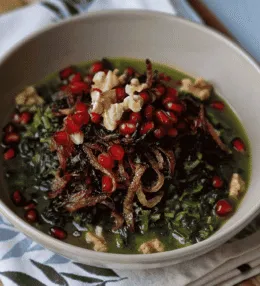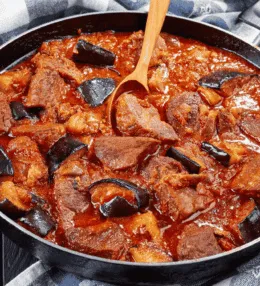
- View
Table of Contents
ToggleEintopf, which translates to “one pot” in German, is more than just a hearty meal, it’s a comforting embrace on a chilly day and a reminder of the simplicity and satisfaction of home, cooked food.
This traditional stew is a cornerstone of German cuisine, celebrated for its versatility and ability to bring people together around a steaming pot filled with nourishing ingredients. With its rich flavours and wholesome appeal, Eintopf embodies the essence of rustic cooking while offering endless possibilities to suit different tastes.
Want to dive deeper into German Cuisine? Don’t miss our post on 33 Traditional German Foods to Try
What Is Eintopf?
Eintopf is a one pot stew that can include a variety of ingredients, making it as flexible as it is flavourful. It’s less a fixed recipe and more a culinary concept, allowing cooks to adapt it based on seasonal produce or what’s available in the pantry.
Commonly, Eintopf includes a combination of vegetables, meat, potatoes, and legumes, all simmered together to create a deeply flavourful and satisfying dish.
The beauty of Eintopf lies in its simplicity. The ingredients are cooked slowly in a single pot, allowing the flavours to meld into a rich and harmonious stew. This method not only enhances the taste but also preserves the nutritional value of the ingredients.
Whether it’s a lentil based Eintopf, a version featuring smoked sausage, or a vegetarian take brimming with root vegetables, the dish is as diverse as the regions of Germany that prepare it.
Ingredients and Taste
The ingredients for Eintopf vary widely, but the foundation often includes a mix of hearty vegetables such as carrots, leeks, and cabbage, along with potatoes or beans to give the stew body.
Meat is frequently added, with options ranging from pork and beef to smoked sausages like bratwurst or mettwurst, which infuse the broth with a savoury depth. Herbs like bay leaves, thyme, and parsley add aromatic layers, while salt and pepper keep the flavours grounded.
As the stew simmers, the ingredients blend together into a dish that’s rich, warming, and deeply satisfying. The vegetables retain their natural sweetness while absorbing the smoky, meaty flavours of the broth.
The result is a comforting dish with a balanced combination of textures, soft, tender potatoes, juicy meat, and just enough bite from the vegetables. The taste is robust yet familiar, a medley of earthy, savoury, and subtly sweet notes that feels like a warm hug in a bowl.
A Taste of History
Eintopf has its roots in German peasant cooking, where resourcefulness and simplicity were key. In the past, families relied on locally grown produce and affordable cuts of meat to create meals that could stretch to feed everyone.
Cooking everything in a single pot conserved fuel and time, making it an efficient and practical solution for busy households. Over time, this humble dish evolved into a beloved staple, with each region of Germany adding its own twist, reflecting local ingredients and culinary traditions.
Eintopf also played a symbolic role in German history. During the early 20th century, it became associated with communal meals and national unity, as the government encouraged people to prepare simple, cost effective dishes in solidarity during difficult times.
Despite its rustic origins, Eintopf is now celebrated as a dish that transcends class and occasion, offering a taste of tradition that’s both comforting and adaptable.
How to Make Eintopf (One Pot Stew)
Eintopf is a beloved German comfort dish that truly lives up to its name, meaning “one pot.” It’s hearty, nourishing, and deeply flavoured from slow simmering vegetables, sausages, and broth together. This rustic stew captures the essence of home-style German cooking: simple, satisfying, and full of warmth. See the recipe card at the bottom for printable directions
Ingredients
- 300 g smoked bacon or pork belly, diced
- 2 tbsp sunflower oil or butter
- 1 large onion, finely chopped
- 2 garlic cloves, minced
- 3 medium carrots, peeled and sliced
- 2 medium potatoes, peeled and cubed
- 1 small leek, cleaned and sliced
- 1 small celery root (celeriac), peeled and diced
- 200 g green beans, trimmed and cut into pieces
- 1 litre beef or vegetable stock
- 2 bay leaves
- 1 tsp dried marjoram
- ½ tsp ground black pepper
- Salt, to taste
- 4 German sausages (such as bratwurst or knackwurst), sliced
- Fresh parsley, chopped (for garnish)
Cooking Instructions
Step 1: Prepare the base
In a large heavy pot, heat the oil or butter over medium heat. Add the diced bacon or pork belly and cook until golden and slightly crisp. This will form the flavour foundation of the stew.
Step 2: Soften the aromatics
Add the chopped onion and garlic to the pot, stirring until translucent and fragrant. Allow them to absorb the rendered fat for a deeper savoury taste before adding the vegetables.
Step 3: Add the root vegetables
Stir in the carrots, potatoes, leek, and celeriac. Sauté for about 5 minutes to lightly caramelise the surfaces, enhancing their natural sweetness.
Step 4: Pour in the stock
Add the beef or vegetable stock, stirring well to deglaze any browned bits at the bottom. Include the bay leaves, marjoram, black pepper, and a pinch of salt. Bring to a gentle boil.
Step 5: Simmer the stew
Reduce the heat to low, cover the pot, and let the stew simmer for about 25 minutes. The slow cooking allows the vegetables and meat to merge beautifully, creating the signature depth of Eintopf.
Step 6: Add the beans and sausages
After 25 minutes, add the green beans and sliced sausages. Continue simmering for another 10–15 minutes until the beans are tender and the sausages heated through.
Step 7: Adjust seasoning
Taste and adjust seasoning if necessary, adding a touch more salt or marjoram. If you prefer a thicker consistency, lightly mash a few potatoes in the pot to release starch.
Step 8: Rest and meld
Turn off the heat and let the stew rest for 5 minutes before serving. This short pause helps the flavours to settle and blend.
Step 9: For serving
Ladle the Eintopf into deep bowls, sprinkle generously with chopped parsley, and serve with a slice of dark rye bread or crusty rolls.
Step 10: Enjoy and store
Eintopf tastes even better the next day once the flavours have matured. Store leftovers in an airtight container in the fridge and reheat gently before serving.
Variations and Substitutions
- Vegetarian version: Omit the bacon and sausages; use vegetable stock and add lentils for protein.
- Meat options: Substitute pork belly with diced beef or smoked ham hock for a richer flavour.
- Sausage substitute: If German sausages are unavailable, use smoked kielbasa or any good-quality smoked sausage.
- Seasoning: Thyme or caraway seeds can be used instead of marjoram for a different regional twist.
Cooking Tips for Perfect Eintopf
- Brown the bacon properly at the start; it builds the stew’s foundation flavour.
- Avoid overcooking the beans; they should stay bright and slightly firm.
- Use homemade stock if possible, for a fuller, more authentic taste.
- Let the stew sit before serving to allow the flavours to round out naturally.

German Eintopf (One Pot Stew)
Equipment
- Large heavy bottomed pot or Dutch oven
- Wooden spoon or spatula
- Ladle
- Knife and cutting board
Ingredients
- 300 g smoked bacon or pork belly diced
- 2 tbsp sunflower oil or butter
- 1 large onion finely chopped
- 2 garlic cloves minced
- 3 medium carrots peeled and sliced
- 2 medium potatoes peeled and cubed
- 1 small leek cleaned and sliced
- 1 small celery root celeriac, peeled and diced
- 200 g green beans trimmed and cut into pieces
- 1 litre beef or vegetable stock
- 2 bay leaves
- 1 tsp dried marjoram
- ½ tsp ground black pepper
- Salt to taste
- 4 German sausages such as bratwurst or knackwurst, sliced
- Fresh parsley chopped (for garnish)
Instructions
- In a large heavy pot, heat the oil or butter over medium heat. Add the diced bacon or pork belly and cook until golden and slightly crisp. This will form the flavour foundation of the stew.
- Add the chopped onion and garlic to the pot, stirring until translucent and fragrant. Allow them to absorb the rendered fat for a deeper savoury taste before adding the vegetables.
- Stir in the carrots, potatoes, leek, and celeriac. Sauté for about 5 minutes to lightly caramelise the surfaces, enhancing their natural sweetness.
- Add the beef or vegetable stock, stirring well to deglaze any browned bits at the bottom. Include the bay leaves, marjoram, black pepper, and a pinch of salt. Bring to a gentle boil.
- Reduce the heat to low, cover the pot, and let the stew simmer for about 25 minutes. The slow cooking allows the vegetables and meat to merge beautifully, creating the signature depth of Eintopf.
- After 25 minutes, add the green beans and sliced sausages. Continue simmering for another 10–15 minutes until the beans are tender and the sausages heated through.
- Taste and adjust seasoning if necessary, adding a touch more salt or marjoram. If you prefer a thicker consistency, lightly mash a few potatoes in the pot to release starch.
- Turn off the heat and let the stew rest for 5 minutes before serving. This short pause helps the flavours to settle and blend.
- Ladle the Eintopf into deep bowls, sprinkle generously with chopped parsley, and serve with a slice of dark rye bread or crusty rolls.
- Eintopf tastes even better the next day once the flavours have matured. Store leftovers in an airtight container in the fridge and reheat gently before serving.
Nutrition
You May Also Like






